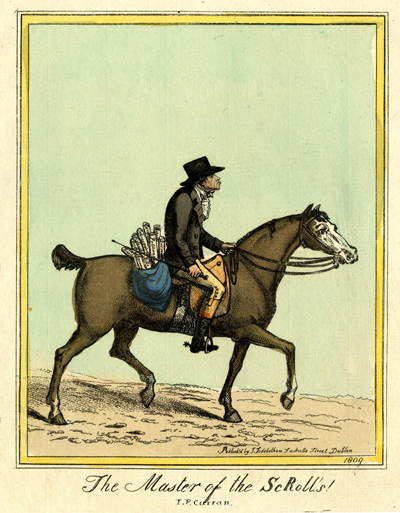The Master of the ScRolls
This is a portrait caricature of the Irish lawyer, politician, and wit, John Philpot Curran, who is perhaps best known as a proponent of Catholic Emancipation, an opponent of the union with England, and the defender of many of the members of the United Irishmen who participated in the uprising of 1798. Late in his career in September/October 1806, he was appointed Master of the Rolls in Ireland, an appointment whose responsibilities consisted of keeping chancery court records. In ancient times many of these records would have taken the form of scrolls. Hence the scrolls protruding from the saddle bags behind him labeled "Decree[s]," "Reports," "Petitions," "Interrogator[ies]," "Affidavits," "Bills," "Brief[s]," and "Answer[s]."

J. Sidebotham [1809]
© Trustees of the British Museum
There were two versions of the print produced in 1809?—both by Irish publishers: one by J. Sidebotham, Sackville Street Dublin, and a second, pirated version by William McCleary, Nassau Street. The print may have been issued to take advantage of, or provide further support for, the publication of The Speeches of the Right Honourable John Philpot Curran which was advertised in the London Star and other newspapers starting in late August, 1808.
A copy of the McCleary version is in the National Portrait Gallery in London where it is listed as "probably by Gillray." The basic design of the print is indeed similar to other Gillray portrait caricatures featuring its subject on horseback, such as Brigade Major Weymouth 1797, A Newmarket Hill Character(1804), and especially A Scotch Poney, Commonly Call'd a Galloway (1803). It also uses the yellow "frame" seen on a number of Gillray portraits such as Enter Cowslip with a Bowl of Cream (1795), La Belle Espagnole (1796), and Mary of Buttermere (1802).
But, there is reason to doubt whether either version was conceived or etched by Gillray. As a long-time supporter of Catholic Emancipation and, like Thomas Erskine, the defender of accused revolutionaries, Curran was just the sort of person Gillray loved to satirize. But in this print there is caricature, but no satire. It is unlikely that Gillray would have been so kind. Secondly, the etching style does not look like Gillray's. Gillray seldom used rollers and or roulettes, preferring to make every stroke himself. The McCleary version, especially, makes extensive use of these labour-saving devices; the Sidebotham version, less so.
Sidebotham had himself been plagiarizing Gillray prints for a number of years with Tales of Wonder (1802) and Company Shocked at a Lady Getting up to Ring the Bell (1804) using the talents of the Brocas family* to etch the prints after Gillray. But in both these cases, there was a Humphrey antecedent. In the case of the 1809 The Master of the ScRolls, there is no Humphrey-published antecedent. And in a print also published the same year, The Extinguisher, Sidebotham specifically includes The Master of the ScRolls as a print pirated by McCleary. It would be a brash publisher indeed who would accuse a fellow publisher of plagiarizing a print that he had himself stolen. So my suspicion is that the Sidebotham's print is in fact by Brocas, not Gillray, imitating Gillray's manner.
* I say "the Brocas family" because it seems unlikely that William Brocas, whose name is in the signature line as the etcher of Tales of Wonder (1802) could have done the work entirely by himself. According to P.J. Raftery, William Brocas was born in 1794, making him only eight years old at the time.
Sources and Reading
- Commentary from the British Museum on The Master of the ScRolls.
- "John Philpot Curran," Wikipedia
- "Master of the Rolls in Ireland," Wikipedia
- The Life of J.P. Curran
- P.J. Raftery, "The Brocas Family, Notable Dublin Artists"," Dublin Historical Record, Vol. 17, No. 1 (Dec., 1961), pp. 25-34.
Comments & Corrections
NOTE: Comments and/or corrections are always appreciated. To make that easier, I have included a form below that you can use. I promise never to share any of the info provided without your express permission.